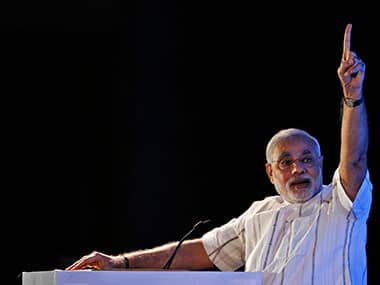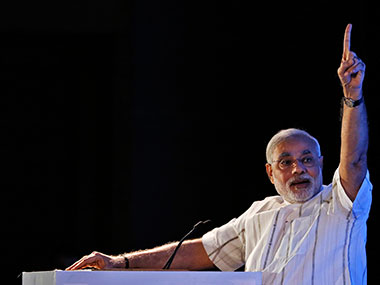From Narendra Modi’s utterances at a gathering of Hindu seers and saints at Haridwar yesterday, one can now begin to discern a pattern on what his future strategy is likely to be – both at the political and personal levels. The emerging political reality is one where Modi has been under attack both from the extreme Right of the Hindu fringe, and “secular” allies such as Nitish Kumar. His rivals in the Congress, of course, are hoping that his mere entry will swing minority votes in their direction. They use every opportunity to remind us about 2002. All these facts would have told Modi that despite his best efforts to reinvent himself as a development and governance icon, his enemies will tie him down to 2002. [caption id=“attachment_734253” align=“alignleft” width=“380”]  Reuters[/caption] In his home state, the Hindutva cabal led by fellow Gujarati Pravin Togadia of the VHP, has been bitter with Modi for severely circumscribing their freedom to create mayhem in the state. Togadia would like to trip Modi by making shrill noises about Hindutva – something the saner elements of the Sangh Parivar know has to be kept in check. The idea is to make Modi unelectable by frightening the minorities. On the other hand, the BJP’s NDA allies want someone other than Modi to head the alliance in 2014 so that their Muslim voter base is not threatened. This is where Modi’s statements at Haridwar, organised by Baba Ramdev’s Patanjali Yogapeeth, offer us a glimpse of his developing strategy. He said: “My manifesto is everyone should be healthy and welfare for all. In Gujarat (where) riots happened every other day and innocents were killed, today after 12 years there is not a sign of riots.” He also said his philosophy was: “Sarve bhavantu sukhina, sarve santu niramaya (let all be happy and healthy)”, and not just “Hindu bhavantu sukhina…. (let only Hindus be happy)”. The significance of his statement is this. First, he has apparently decided to start addressing the issue of the riots. This is why he talked of 12 years of riot-free Gujarat. You can’t talk of post-2002 without talking about 2002. He is probably preparing to deal with the 2002 allegations in some form or the other before the next elections. Second, the statement, at a Hindu gathering, that he is for the welfare of all and not just Hindus serves two opposite purposes: he is sending a message to the Togadias that he has the blessings of saints. And also that secularism flows from the Hindu idea of “sarve bhavantu sukhina”. His point, that happiness is not just for Hindus, is indicative of his need to address the minority constituency in some way before the next elections. Third, the critical political alliance he seems to have sealed is with Baba Ramdev, who endorsed his candidature for Prime Ministership. The Baba has a large OBC following in the Hindi belt and this shows that Modi is planning to make a big splash in these states, especially Uttar Pradesh and Bihar. This alliance should give both the Congress, which has been hounding the Baba, and Hindi belt politicians - ranging from Mulayam Singh to Lalu Yadav and Nitish Kumar – cause for pause. Modi is not going to be a pushover merely by being demonised as anti-minority. He is working on his options. Fourth, as _Firstpost_ noted earlier this week, a new track-II approach is being launched to open communication lines with the Muslim leadership in Uttar Pradesh. While this is a tough task, what is absolutely clear is that Modi is finally going to address what everyone thinks is his Achilles heel: his anti-minority image and accountability for 2002. Fifth, the decision to stay away from too much campaigning in Karnataka is tactical and also sensible since Modi cannot afford to reveal his entire hand in advance. His strategy will work best if unveiled closer to the main elections rather than now. Sixth, his visit to Sivagiri, where the ashram of social reformer Sree Narayana Guru is located, suggests that even though he will not play caste politics overtly, he is willing to reach out these constituencies subtly. Sree Narayana Guru helped Ezhavas (a large OBC group) gain self-respect in the face of upper caste discrimination. Modi, who also hails from a most backward caste, is clearly making his moves adroitly. One should expect more surprises as the Modi strategy unfolds in the coming months.
Modi appears to be getting ready to address the issue of 2002 and his apparent lack of acceptability to minorities.
Advertisement
End of Article
Written by R Jagannathan
R Jagannathan is the Editor-in-Chief of Firstpost. see more


)
)
)
)
)
)
)
)
)



